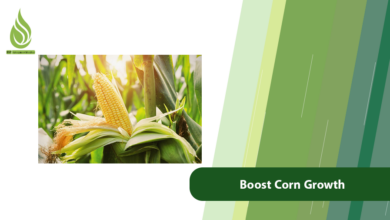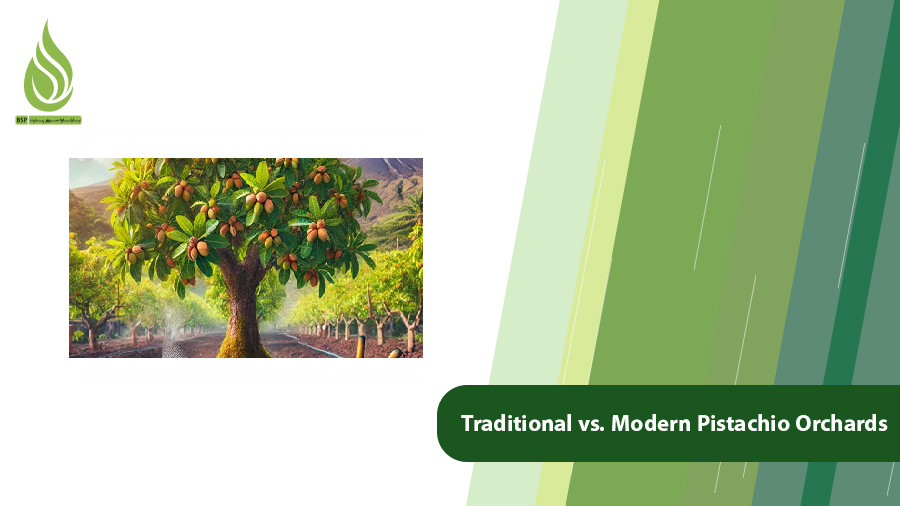
Traditional vs. Modern Pistachio Orchards: A Complete Comparison
Pistachios stand as one of the world’s most valuable nut crops, playing a pivotal role in global agriculture, particularly in arid regions like the Middle East. As a strategic export for countries such as Iran, pistachios contribute significantly to non-oil revenues and support livelihoods for millions of farmers. Worldwide, pistachio production has seen steady growth. However, growers worldwide, especially in water-scarce areas, are grappling with the choice between sticking to time-honored traditional methods or embracing modern techniques to boost efficiency and yields in pistachio orchards.
Are traditional pistachio orchards better, or do modern ones hold the edge? We’ll explore the features, advantages, and drawbacks of both approaches. We also examine how modernization can enhance performance while addressing challenges like water scarcity and climate change. Additionally, we’ll discuss the role of targeted nutrition, including fertilizers like ammonium sulfate, which can optimize soil health and nut quality in these orchards.
The Push Toward Modernization in Pistachio Orchards and Its Impact on Tree Performance
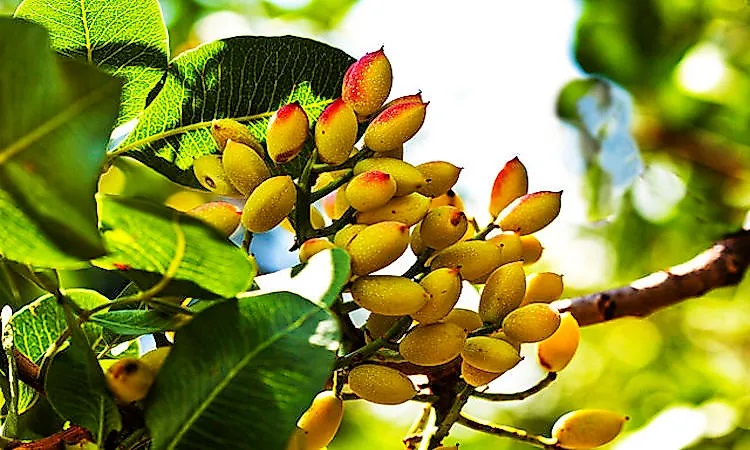
In recent decades, global agriculture has shifted toward modernization, leveraging technology to improve yields and resource efficiency. This trend is especially critical for pistachios, a crop native to the Middle East and Central Asia, where arid climates demand innovative water management. Iran, historically the world’s top producer until surpassed by the U.S. in recent years, must adapt to maintain its market share amid rising global demand. Projections indicate U.S. production could exceed 2 billion pounds soon, highlighting the need for Middle Eastern growers to invest in advanced methods.
Developing high-performing pistachio orchards requires informed decisions in scientific management, advanced irrigation, and precise nutrition. These strategies not only boost yields but also preserve soil and water resources, which are under threat from overexploitation and climate variability. Pistachios are prized for their high economic value, stable export markets, and tolerance to saline soils, making them a go-to crop for farmers in regions like Iran’s Rafsanjan area or Turkey’s southeastern provinces. Yet, many orchards fall short of potential due to foundational errors during establishment, such as poor rootstock selection or inadequate soil preparation.
In advanced nations like the United States, growers achieve yields of around 1 ton per hectare by year six, scaling up to 5 tons by year 12 through careful cultivar choices adapted to local climates. In contrast, well-managed Iranian orchards average about 1 ton per hectare after 20 years, underscoring the yield gap. Traditional Middle Eastern farmers often discover mismatched cultivars years into cultivation, leading to costly replanting that delays profitability. Modern approaches, however, can quadruple yields over national averages by applying science from the outset.
Starting with land preparation is crucial: selecting suitable cultivars, ensuring proper soil nutrition, and implementing pest control. In the Middle East, where water tables are depleting rapidly, modernization isn’t just an option; it’s essential for survival. Recent studies show that climate change could shift suitable cultivation areas in the Middle East, with rising temperatures potentially reducing viable zones unless adaptive measures like drought-resistant varieties are adopted.
Key Features of Traditional Pistachio Orchards
Traditional pistachio orchards, prevalent in the Middle East, rely on age-old practices passed down through generations. These include older tree varieties, flood irrigation, and manual methods for pruning, fertilizing, and pest control. Trees are often planted based on local knowledge, without extensive soil testing or genetic selection.
Core characteristics include:
- Surface or furrow irrigation systems, where water flows across the field.
- Imprecise fertilizer and water application, often based on visual cues rather than data.
- No structured monitoring for tree nutrition.
- Conventional pruning and pest management techniques.
- Lower yields due to soil degradation and nutrient deficiencies over time.
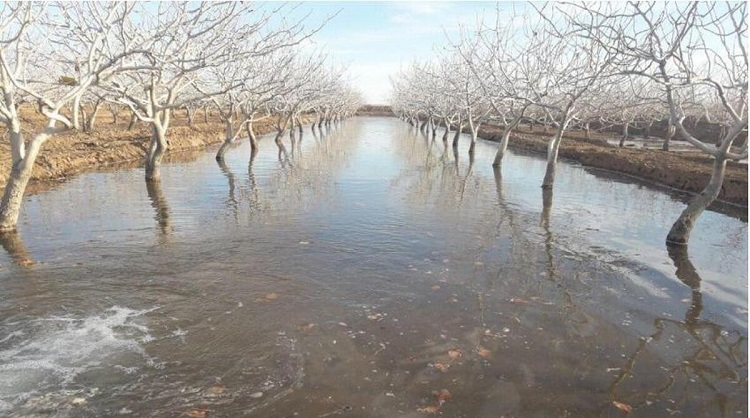
In Iran, traditional methods dominate smaller family farms, where pistachios have been cultivated for centuries in regions like Kerman province. Similarly, in Turkey, many orchards in Gaziantep use these approaches, blending cultural heritage with practical farming.
Advantages of Traditional Pistachio Orchards
Traditional methods offer simplicity and cultural continuity, appealing to growers in resource-limited areas.
- Natural Management Practices: They emphasize organic approaches, reducing reliance on chemicals and preserving biodiversity.
- Preservation of Local Traditions: Skills are handed down, fostering community knowledge and involving younger generations in ancestral practices.
- Lower Initial Costs: Setup requires minimal investment; no expensive drip systems or sensors. Flood irrigation uses existing infrastructure, keeping startup expenses down.
In the Middle East, these benefits help smallholders enter the market without heavy debt, supporting rural economies where pistachios account for significant income.
Drawbacks of Traditional Pistachio Orchards
Despite their appeal, traditional orchards face inefficiencies in a changing world.
- Reduced Yields: Without optimization, production lags behind modern standards.
- Higher Labor Demands: Manual tasks increase workforce needs, inflating costs.
- Increased Manual Work: From harvesting to weeding, everything is hands-on, leading to fatigue and errors.
- Vulnerability to Climate Shifts: Flood irrigation wastes water, exacerbating droughts common in the Middle East.
In Iran, traditional practices have contributed to groundwater depletion, with some areas seeing yields drop by 40% due to climatic risks. This highlights the need for evolution to sustain production.
Defining Modern Pistachio Orchards and Their Differences from Traditional Ones
Modern pistachio orchards are built on scientific principles and cutting-edge technology, starkly contrasting traditional setups. In the U.S., orchards in California’s San Joaquin Valley exemplify this, using data-driven decisions for every aspect. In the Middle East, progressive Iranian and Turkish farmers are adopting similar models to combat water shortages.
Key features include:
- Drip or smart irrigation systems that deliver water precisely.
- Improved, drought-resistant seedlings.
- Fertilization based on soil and leaf analyses.
- Integrated pest management (IPM) with biological controls.
These result in yields 3-5 times higher while optimizing resources. In Iran, modern orchards can achieve 180,000 tons in a good year, up 70% from frost-affected seasons, thanks to tech adoption.
Advantages of Modern Pistachio Orchards
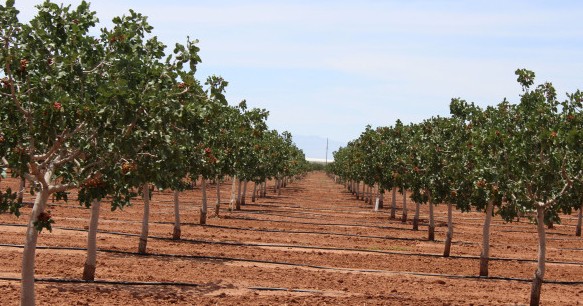
Modernization brings tangible benefits, particularly in yield and sustainability.
- Boosted Production: Nutrition plans from soil tests prevent over-fertilization, enhancing nut size and .flavor. We suggest you take a look at our guide to fullness of pistachios
- Less Manual Labor: Automation saves time and reduces costs.
- Efficient Fertilization: While organic options exist, chemical fertilizers like ammonium sulfate provide quick nitrogen and sulfur boosts, ideal for alkaline soils common in the Middle East. Ammonium sulfate acidifies soil, improving nutrient uptake and nut quality, with studies showing enhanced factors like kernel weight in Iranian orchards.
- Water Savings: Drip systems cut waste by 50-60%, crucial in arid zones. They promote uniform growth and better kernel development.
- Pest Management: IPM reduces chemical use, lowering environmental impact and costs.
In the U.S., these practices have propelled production to record levels, with 1.5 billion pounds in 2023. Middle Eastern adopters report similar gains, with drip irrigation improving seedling growth and overall health.
Drawbacks of Modern Pistachio Orchards
Modern systems aren’t without challenges.
- Higher Upfront Costs: Purchasing improved seedlings and equipment can be prohibitive, though long-term savings offset this.
- Technical Knowledge Required: Farmers need training, but resources like extension services make it accessible.
In Iran, initial investments are recouped through reduced labor and water bills, making modernization viable even for medium-sized operations.
Comparing Performance Between Traditional and Modern Pistachio Orchards
Modern orchards generally outperform traditional ones due to technology. Yields can be 2-5 times higher, with superior nut quality in terms of size, color, and split rate. While setup costs more, long-term profits soar through efficiency.
| Aspect | Traditional Orchards | Modern Orchards |
|---|---|---|
| Yield (tons/ha) | 0.5-1 (after 20 years) | 3-5 (by year 12) |
| Water Use | High (50-60% waste) | Low (50% savings via drip) |
| Labor Costs | High (manual intensive) | Low (automated) |
| Pest Control | Chemical-heavy, costly | IPM, eco-friendly |
| Climate Resilience | Low | High (drought-resistant varieties) |
Data from Iran shows modern methods could stabilize output amid climate volatility, where traditional yields fluctuate wildly. In the U.S., consistent high yields demonstrate the model’s success.
Benefits include:
- Greater long-term profitability.
- Reduced inputs for water, fertilizer, and pesticides.
- Improved product quality for premium markets.
- Economic stability in droughts.
Strategies for Modernizing Pistachio Orchards
Transitioning to modern practices involves targeted investments. Here’s a detailed breakdown:
- Implementing Advanced Irrigation Systems: Drip and sensor-based systems are core, saving up to 50% water and reducing erosion. In Iran, subsurface drip has boosted efficiency, with fertigation delivering nutrients like ammonium sulfate directly to roots for better absorption. This method is particularly effective in alkaline soils, where ammonium sulfate lowers pH to enhance iron and other micronutrient availability, leading to fuller nuts. Recent trials show pistachio seedlings thrive under drip, with improved growth metrics. For Middle Eastern farmers, starting with partial irrigation upgrades can yield immediate returns, especially as climate change intensifies water stress.
- Selecting Improved Cultivars and Seedlings: Modern orchards use genetically enhanced varieties resistant to salinity, pests, and drought. In the U.S., ‘Kerman’ on ‘UCB-1’ rootstock dominates for high yields. Iran is breeding similar lines, with faster-bearing trees reducing time to profitability.
- Precision Fertilization Management: Soil and leaf tests guide applications. Ammonium sulfate, providing 21% nitrogen and 24% sulfur, is ideal for pistachios, promoting vegetative growth and nut fill. In alkaline Middle Eastern soils, it corrects pH imbalances, boosting quality factors like kernel size. Apply 1-2 pounds per tree in early growth stages, split for efficiency.
- Scientific Pest and Disease Control: IPM uses monitoring, pheromones, and natural predators, minimizing sprays. In Iran, this cuts costs and aflatoxin risks, a key export barrier.
- Integrating Smart Technologies: Drones for monitoring, IoT sensors for soil data, and farm software streamline operations. In the U.S., these tools reduce errors; Middle East adoption is growing amid export demands.
- Proper Pruning Techniques: Data-based pruning improves light and air flow, enhancing yields. Use sanitized tools to prevent disease spread.
- Soil Enhancement Practices: Annual analyses, organic amendments, and minimal tillage maintain fertility. Managing soil pH and salinity is vital in the Middle East, where ammonium sulfate aids in this.
- Infrastructure Upgrades: Optimal spacing, hail nets, and water storage bolster resilience.

The Role of Climate Change in Pistachio Production and the Necessity of Modernization
Climate change poses severe threats to Middle Eastern pistachio farming, with rising temperatures and erratic rainfall shifting cultivation zones in Iran. Groundwater depletion in areas like Rafsanjan could halve outputs without intervention. Modern techniques, like efficient irrigation and resilient varieties, mitigate these by conserving water and adapting to warmer conditions. In contrast, traditional methods amplify vulnerabilities, with drought risks rising across the region.
Global warming also affects chilling hours needed for dormancy, potentially reducing yields by 40% in susceptible areas. However, supplemental irrigation in rainfed orchards can boost productivity significantly. For exporters, adapting ensures supply stability, as seen in Iran’s 55% export surge to China in 2024/25.
Is Modernizing Pistachio Orchards Essential?
With depleting aquifers and climate shifts, traditional farming is increasingly untenable in many Middle Eastern regions. Technologies like smart irrigation and precise fertilization, including ammonium sulfate for nutrient balance, promise a sustainable future. While initial costs are higher, the payoff in higher yields, lower inputs, and market competitiveness is clear.
Traditional orchards can evolve gradually, blending heritage with science. Ultimately, the choice depends on individual circumstances, but for those eyeing long-term viability and profits, modernization is the superior path. Combining local wisdom with global innovations could secure pistachio’s place as a Middle Eastern staple, supporting economies amid growing demand.
